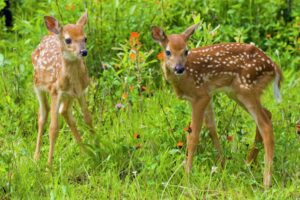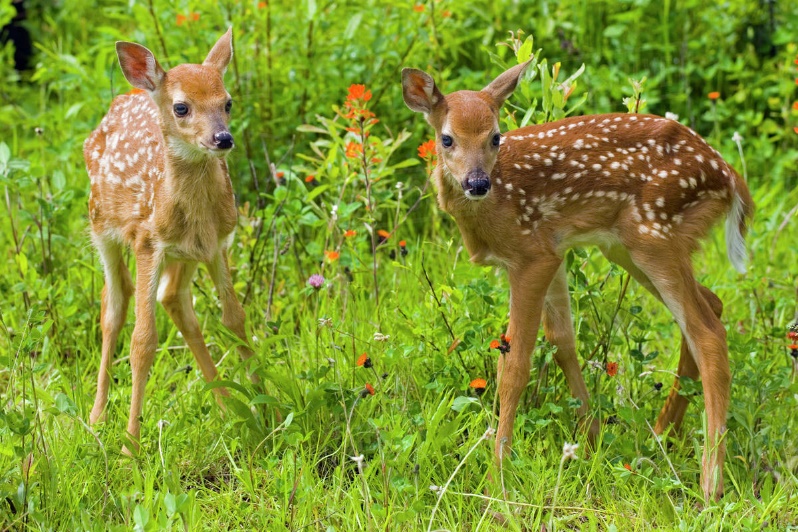Last Friday and early this week, we had a couple new additions to our deer herd at the Forest County Deep Park. It made me think that it’s that time of year … when you can almost stumble over a well-hidden fawn.
White-tailed deer fawns are usually born about six months after mating. In Northern Wisconsin that is late May through June. A yearling doe will usually give birth to one fawn while older does can give birth to twins or sometimes even triplets.
 When fawns are born, the mother takes several steps to carefully prepare the fawn for concealment from predators. First, the mother will take her time to clean the fawn to remove her own scent. She will also consume the afterbirth, not only to reduce the risk of predation, but to recycle nutrients that are necessary for milk production. Within hours of birth, a fawn will begin to test its legs, ultimately wobbling awkwardly along behind their mother on their way to the best available hiding spot. Once a safe distance away from the birthing spot, the fawn will instinctually lie down in cover. The mother will leave the immediate area so she doesn’t attract predators. This all happens within about ten hours of birth.
When fawns are born, the mother takes several steps to carefully prepare the fawn for concealment from predators. First, the mother will take her time to clean the fawn to remove her own scent. She will also consume the afterbirth, not only to reduce the risk of predation, but to recycle nutrients that are necessary for milk production. Within hours of birth, a fawn will begin to test its legs, ultimately wobbling awkwardly along behind their mother on their way to the best available hiding spot. Once a safe distance away from the birthing spot, the fawn will instinctually lie down in cover. The mother will leave the immediate area so she doesn’t attract predators. This all happens within about ten hours of birth.
For the first seven to 10 days of life, a fawn will spend up to 95 percent of its time bedded. Hiding is the primary survival mechanism of fawns; they are not abandoned by the doe. So, it’s best to leave them be. While bedded, a fawn has a very rapid heartbeat of around 175 beats per minute. When a fawn senses danger is close, it will lower its head and drop its ears, the heart rate will fall to around 60 beats per minute, and the breathing will become slower and deeper – all to try and avoid detection by predators. At about 10 days old they are able to run from danger.
Fawns weigh about 6-8 pounds at birth. Immediately after birth the doe will nurse the fawn. The milk of a doe is rich in fat, protein, dry solids and energy, helping the fawn grow. Fawns of multiple fawn litters will grow slower than fawns of single litters. Fawns usually double their birth weight in roughly two weeks and triple it within a month. On average, fawns gain 0.44 pounds per day during this time. Does are under a lot of stress during this time in order to feed the fawns. Does nurse their fawns about four times a day when newborn and will continue to nurse them until they are about four months old.
At about two weeks old fawns will start to browse tender vegetation. They learn from their mother what plants to eat. Generally, does obtain their peak weight at four years old with an average weight of 100 pounds. Bucks usually reach their peak weight at age five or six and have an average weight of 150 pounds. Deer spend more time eating than in any other activity.
The white-tailed deer is an herbivore—it eats plants. Deer graze on tree leaves, broadleaved herbs, and berries in the summer and acorns, grass, and herbs during the fall. During the winter, deer munch on white cedar, twigs, nuts, fruits, and corn and in the spring, deer eat grass, wheat, and alfalfa. In the winter they also eat buds and twigs from maples, dogwood, aspen, willow and sumac. Deer have a four-chambered stomach that allows them to digest these plant foods. They gobble up their food quickly and hardly even chew. Later as they are resting, they cough up their food and re-chew it.
Deer fawns have a set of baby teeth just like humans. They are born with four teeth and in the next few months develop baby incisors and premolars. By the time they are about 18 months old, permanent teeth will have replaced the baby teeth.
Contrary to popular belief, fawns are actually not born odorless, in fact, the unique scent of each individual fawn is actually how the mother identifies her own. Twins and triplets are also hidden separately to increase their survival probability.
Fawns have a red and brown coat with white spots. This coat helps them blend in with the sunlight and the shade. The average number of spots on a fawn coat range from 272 to 342, with the size of each spot ranging from 0.24 to 0.51 inch in diameter. Fawns will lose this coat in August and September when they start replacing their summer coat with a heavier, grey brown winter coat.
For more information contact Steve Kircher, County Conservationist-Land Information/GIS Director at 715-478-1387 or by e-mail at .

